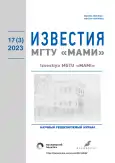Алгоритм формирования уставок крутящего и тормозного моментов на валу тягового электродвигателя посредством одной педали
- Авторы: Климов А.В.1,2
-
Учреждения:
- Инновационный центр «КАМАЗ», Инновационный центр Сколково
- Московский политехнический университет
- Выпуск: Том 17, № 3 (2023)
- Страницы: 261-271
- Раздел: Транспортные и транспортно-технологические комплексы
- URL: https://journal-vniispk.ru/2074-0530/article/view/249927
- DOI: https://doi.org/10.17816/2074-0530-321668
- ID: 249927
Цитировать
Полный текст
Аннотация
Обоснование. Эксплуатирующие организации и рядовые потребители предъявляют к транспортным средствам требования к повышению их энергоэффективности, снижению затрат, а также повышение энергономичности и комфортабельности. Одной из значимых затрат при эксплуатации транспортного средства является затрата на топливо, поэтому весьма перспективно применять транспортные средства с электрическими приводами, такие как — аккумуляторные электрические. Для них весьма важно иметь энергоэффективное управление тяговыми приводами, основными источниками потерь энергии, отличающимися высокой эффективностью, увеличивающее их автономный пробег на одной зарядке. Для этого необходимо формировать уставки запрашиваемого момента двигателя с использованием только педали хода с учётом условий движения и характеристик транспортного средства во всём диапазоне скоростей.
Цель работы — является разработка теоретических основ и закона определения уставок тягового и рекуперативного крутящего момента тягового электропривода, режима выбега в зависимости от скорости движения и уровня положения педали хода с учётом обеспечения требуемого уровня комфортабельности и эргономичности управления.
Материалы и методы. Моделирование закона определения уставки тягового и рекуперативного крутящего момента тягового электропривода, режима выбега выполнено в программном комплексе Matlab Simulink.
Результаты. В статье приводятся теоретические основы построения закона формирования определения уставки тягового и рекуперативного крутящего момента тягового электропривода, режима выбега для эффективного управления, повышения его энергономичности, комфортабельности транспортного средства, а также результаты виртуального имитационного моделирования формирования уставок в Matlab Simulink в условиях, приближенных к эксплуатационным.
Заключение. Практическая ценность настоящего исследования заключается в возможности использования предложенного закона определения уставки тягового и рекуперативного крутящего момента тягового электропривода, режима выбега для разработки системы управления тягового привода транспортных машин.
Полный текст
Открыть статью на сайте журналаОб авторах
Александр Владимирович Климов
Инновационный центр «КАМАЗ», Инновационный центр Сколково; Московский политехнический университет
Автор, ответственный за переписку.
Email: klimmanen@mail.ru
ORCID iD: 0000-0002-5351-3622
SPIN-код: 7637-3104
Scopus Author ID: 57218166154
канд. техн. наук, доцент Передовой инженерной школы электротранспорта; руководитель службы электрифицированных автомобилей
Россия, Москва; МоскваСписок литературы
- Характеристики электробуса КАМАЗ 6282. Набережные Челны: Камаз. Дата обращения: 15.10.2022. Режим доступа: https://kamaz.ru/upload/bus/%D0%AD%D0%BB%D0%B5%D0%BA%D1%82%D1%80%D0%BE%D0%B1%D1%83%D1%81%20KAMAZ-6282.pdf
- Жилейкин М.М., Климов А.В., Масленников И.К. Алгоритм формирования управляющего сигнала со стороны педали акселератора, обеспечивающий энергоэффективное потребление электроэнергии тяговым приводом электробуса // Известия МГТУ «МАМИ». 2022. Т. 16, № 1. С. 51–60. doi: 10.17816/2074-0530-100232
- Бирюков В.В., Порсев Е.Г. Тяговый электрический привод: учеб. пособие. 2-е изд. Новосибирск: Изд-во НГТУ, 2018.
- Kulas R.A., Rieland H., Pechauer J. A System Safety Perspective into Chevy Bolt’s One Pedal Driving // SAE Technical Paper. 2019. Vol. 01. P. 0133. doi: 10.4271/2019-01-0133
- Wang J., Besselink I.J.M., van Boekel J.J.P., et al. Evaluating the energy efficiency of a one pedal driving algorithm. 1–10 // 2015 European Battery, Hybrid and Fuel Cell Electric Vehicle Congress (EEVC 2015), Brussels, Belgium. Brussels, 2015.
- Жилейкин М.М., Котиев Г.О. Моделирование систем транспортных средств: учебник. М.: МГТУ им. Н.Э. Баумана, 2020.
Дополнительные файлы























